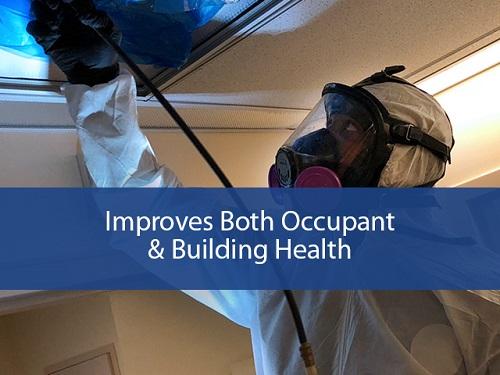

Think of it this way: you wouldn’t go to the doctor for a check-up and expect to get a clean bill of health without a thorough examination and a few tests. The same is true of any HVAC system. As such, I recommend facilities managers work with a qualified HVAC service company with expertise in indoor air quality (IAQ) and building scientists and microbiologists on staff. They may even want to consider using a rigorous third-party certification process, like that of the WELL building institute to provide an extra layer of assurance.
Facilities managers should choose a firm whose standard practice is to carefully inspect and test a system prior to prescribing any services or new products. In the case of a sporting venue, its HVAC system may have lain dormant for some time. A test for biological contaminants such as bacteria, including Legionella, and mold is necessary. As part of a thorough inspection, HVAC professionals should seek to identify any buildup of particulate or debris that is obstructing airflow through the system. They also need to assess the physical condition of the equipment and find leaks that may allow pathogens to bypass filters and gain access to the system.
Many facilities managers we are working with are considering system upgrades or supplements that might decrease the risk of COVID-19 transmission during one of their events. There are two primary routes to take when supplementing ventilation and filtration as recommended by the American Society of Heating, Refrigeration, and Air Conditioning Engineers (ASHRAE). The first is system technologies which include ultraviolet energy (UV-C) and bipolar ionization. The second is localized air cleaning technologies which include in-room portable air cleaners.
Most of these technologies or devices have shown to be effective for the specific task they were designed for. However, no single air cleaning technology is completely effective on its own. It is when the right technologies are combined that they provide a holistic approach for maximum efficacy against indoor pathogens.
For example, UV-C exposure is commonly used within an HVAC system to disinfect the equipment more than the air. This is because air travels through the system at around 7 mph. Pathogens in the air flow do not dwell within the UV-C zone long enough to be killed. Since UV-C exposure is harmful to humans, it cannot be used in an occupied space. However, there is UV-C equipment that can be deployed in the occupied space that is used after hours or switches on and off with motion sensors.
Bipolar Ionization is typically mounted within the system, is always on and produces ions that travel throughout the airstream. These positively and negatively charged ions naturally try to find an oppositely charged ion to bond with. In the case of microbiological pathogens, the ion seeks to bond with hydrogen molecules contained therein. When the ion pulls the hydrogen molecule away from the SARS-CoV-2 virus, the virus is killed.
Finally, in-room air cleaners provide an extra layer of protection where it matters most: where athletes, fans or even the news media are located. The most effective air purifiers have a multi-stage filter system that includes a HEPA stage, plus motion/occupancy detection, multiple fan speeds, a panel that displays the indoor conditions, and quiet operations. Some even include their own bipolar ionization, too. Keep in mind, an in-room air cleaner must be rated to handle the volume of air present in the space or its ability to reduce the risk of COVID exposure will be compromised.
Once a system has been inspected, cleaned and upgraded, then an important step that a lot of facilities managers overlook is communicating it to their guests. By sending a letter to the venue users, teams, media, security staff, et al, outlining the steps a facility has taken, a facilities manager can reassure them that the facility is focused on their safety. They also can place posters and signage throughout the venue reminding visitors, guests and employees of efforts made on their behalf.
Our firm has worked extensively with professional sports leagues like the NHL and NBA during the pandemic. It is apparent they want to protect their investments in player and staff health. This desire is being cascaded down to the venues, too, and they in turn are focusing on ensuring safety and instilling confidence for returning fans. The obvious concerns for leagues are training facilities, locker rooms player lounges and the benches. We have seen some teams directly acquire portable air cleaning technologies to travel with. On the venue side we are seeing a focus on luxury suites, press and coaching boxes, and bathrooms -- basically, any enclosed space.
In speaking to event managers, as you consider which facility to choose to host your event, you may want to emulate the various professional sports leagues we have worked with and ask the following questions of the venue:
- Are you adhering to CDC recommendations, including cleaning, for safe operation?
- Have you implemented the ASHRAE guidance for the re-opening of buildings? Have the installed air cleaning technologies been rigorously tested for efficacy against coronavirus or a surrogate?
- Do you regularly inspect your indoor air quality and HVAC system?
As you conduct a site inspection, look out for the following indicators that there may be problems with a building’s HVAC system:
- Streaks of dirt – this is what we call particulate blowout. Check to see if it is surrounding the air vents.
- Odors – this usually means bacteria and/or mold.
- Air flow -- is there adequate airflow from the vents?
- Temperature -- does the system struggle to maintain the desired temperature of the building?
- Humidity -- does the building feel humid or can you see condensation on its surfaces?
All of these situations can exacerbate the spread of microbial, like the coronavirus, in the indoor environments.
As we return to hosting more and more live events, remember that COVID is an airborne virus and the best way to combat it is by ensuring that your facility is prepared to provide clean, pathogen-free air to all your guests. Being able to share with your guests that you have taken these recommended steps to ensure air quality will greatly enhance their experience at your facility and burnish your reputation as a first class venue.

